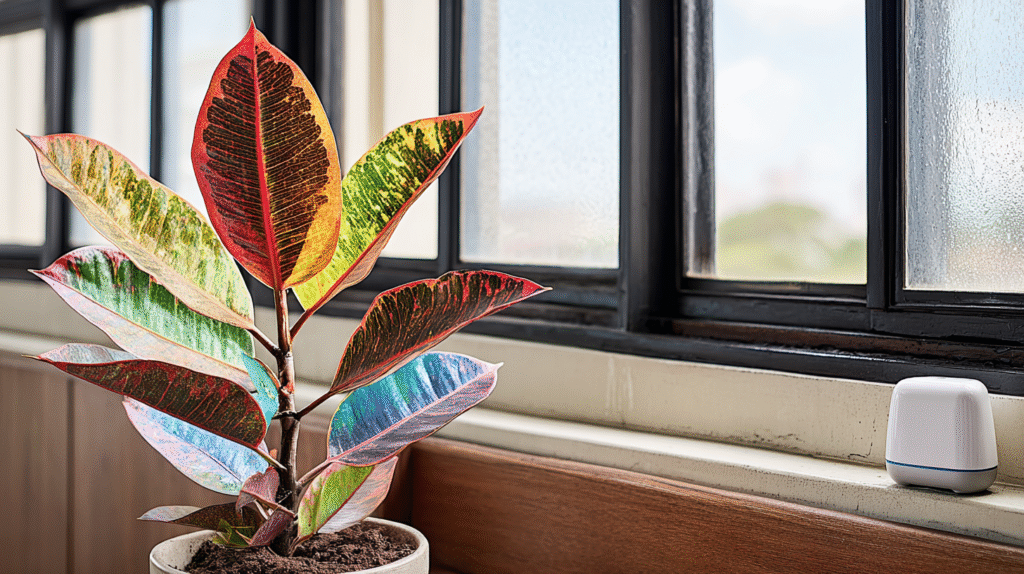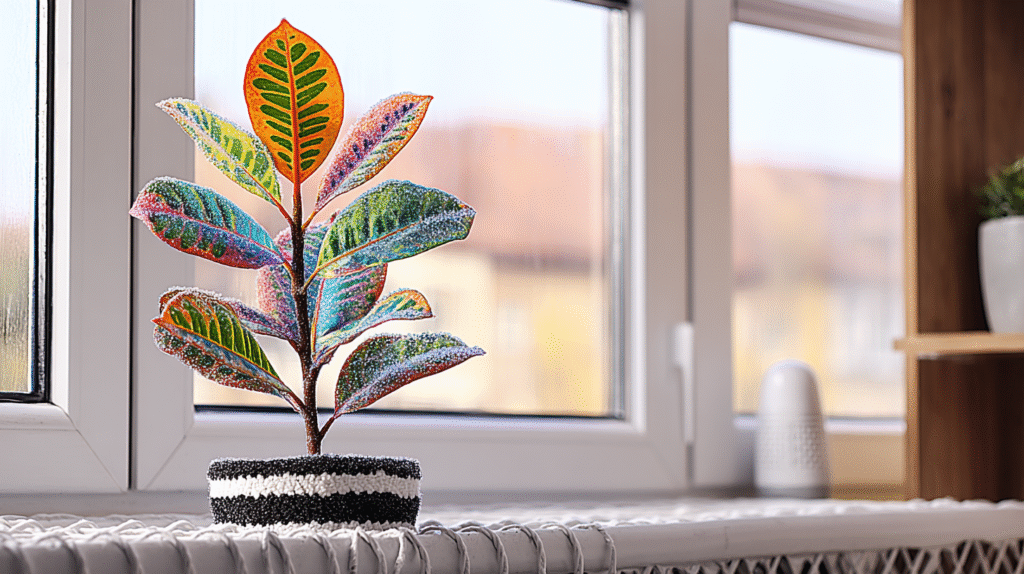I’ll never forget the first time I saw a croton. Walking through Home Depot’s garden center, this plant literally stopped me in my tracks. Leaves that looked like someone went crazy with a paintbrush—red, yellow, orange, pink, all swirled together like a tropical sunset. Obviously, I had to have it.
Three weeks later, I was sweeping up fallen leaves like it was autumn in my living room. My gorgeous croton had transformed into a sad, mostly-green stick with maybe five leaves hanging on for dear life. Turns out, crotons are the divas of the houseplant world, and I’d done literally everything wrong.
But here’s the thing—once you crack the croton code, they’re actually not that hard. I’ve now kept the same croton alive and thriving for three years. It’s over four feet tall, looks like a firework explosion, and people literally ask if it’s real. Here’s everything I learned the hard way so you don’t have to.
Why Crotons Have a Bad Reputation (And Why It’s Only Half True)
Everyone warns you about crotons. “They’re difficult!” “They drop leaves if you breathe wrong!” “Good luck keeping the colors!” And yeah, they’re not exactly pothos-level easy. But they’re also not the impossible plants people make them out to be.
The truth? Crotons are just incredibly dramatic about change. Move them to a new spot? Leaf drop. Change their watering schedule? Leaf drop. Look at them funny on a Tuesday? Okay, maybe not that bad, but you get the idea.
Once you understand they’re basically the theater kids of houseplants, everything makes sense.
The Light Situation (AKA Why Your Croton Looks Like Sad Lettuce)
Let’s talk about the biggest croton myth: “They need full sun.” Sure, if you want fried plant chips. What crotons actually need is bright, bright light—but not necessarily direct sun all day.
Here’s my setup that finally worked: East-facing window, right up against the glass. My croton gets about 3-4 hours of direct morning sun, then bright indirect light the rest of the day. The colors went from mostly green with hints of other shades to full-on rainbow explosion within two months.
Not enough light is why most crotons fail indoors. That pretty corner spot across from a window? Too dark. That shelf near the window? Still too dark. These plants want to sunbathe, just not at high noon in Death Valley.
Quick test: If you can’t read a book comfortably where your croton sits, it needs more light. Period.

Watering: The Goldilocks Game
Remember Goldilocks? Too hot, too cold, juuust right? That’s crotons with water. They hate being too dry. They hate being too wet. They want that perfect moisture level that makes you question your sanity.
Here’s what actually works: I water when the top inch of soil is dry but the rest still feels slightly damp. For my croton in its 10-inch pot, that’s about every 5-7 days in summer, every 10-14 days in winter. But forget counting days—stick your finger in that soil.
The leaves tell you everything:
- Drooping leaves that perk up after watering = too dry
- Drooping leaves that don’t perk up = too wet (uh oh)
- Lower leaves turning yellow and dropping = probably overwatering
- Crispy brown edges = underwatering or humidity issues
I water until it runs out the drainage holes, let it drain completely, then put it back. No sitting in water, ever. Crotons will throw a fit.
The Humidity Drama Nobody Warns You About
You know what made the biggest difference for my croton? A $15 humidifier. These plants come from tropical places where the air feels like soup. Your house in winter? Basically the Sahara.
My first winter with a croton was tragic. Leaves dropping daily, edges turning brown and crispy, colors fading to sad green. I tried misting (made things worse—more on that later), pebble trays (barely helped), and grouping plants (slight improvement).
Then I bought a small humidifier and aimed it near my croton. Game. Changer. Leaves stopped dropping, colors stayed vibrant, and new growth exploded. I keep humidity around 50-60% now, and my croton looks like it’s on steroids.
Skip the misting, seriously. It doesn’t actually raise humidity much, and wet leaves can lead to fungal issues. Trust me, I learned this after dealing with leaf spot disease. Not fun.

Temperature: The Secret Croton Killer
Here’s something nobody told me: crotons are bigger babies about temperature than a newborn. They want it between 60-85°F, and they mean it. No cold drafts, no heating vents, no air conditioners blowing on them.
My croton lived next to a window that I’d crack open in winter for “fresh air.” Every time I did, leaves would drop within 24 hours. Moved it away from the window, problem solved. They literally cannot handle cold drafts. At all.
Also, that spot near your heating vent that seems perfect because it’s warm? Nope. The dry air will crisp your croton faster than you can say “leaf drop.”
Feeding Your Diva Plant
Crotons are hungry plants during growing season. I fertilize every 2-3 weeks in spring and summer with regular liquid houseplant food at half strength. Full strength burned some leaves—learned that the hard way.
In fall and winter, I cut back to once a month or stop completely if it’s not actively growing. You’ll know it’s growing when you see those tiny, light green baby leaves at the tips. No babies? No food needed.
Pro tip: I started using worm casting tea once a month, and my croton’s colors got insanely vibrant. Something about the gentle, organic nutrients really works for these plants.
The Dreaded Leaf Drop (And Why It’s Sometimes Normal)
Real talk: your croton WILL drop leaves. It’s not always your fault. Old leaves at the bottom naturally fall off as the plant grows. That’s normal. What’s not normal is losing multiple leaves daily or all the leaves on one side falling off.
Reasons for dramatic leaf drop:
- Just brought it home (adjustment period)
- Moved it to a new spot (drama queen behavior)
- Temperature changes (even small ones)
- Watering inconsistency
- Pest problems (check for spider mites)
- Not enough light (the slow, sad decline)
When I first brought mine home, it dropped 15 leaves in a week. I almost threw it out. But I kept the conditions stable, and it bounced back with even better growth. Sometimes you just have to wait out their tantrum.
Pests: The Uninvited Guests
Spider mites love crotons like cats love cardboard boxes. Check regularly by looking at the undersides of leaves. See tiny webs or stippled yellow dots? You’ve got mites.
My solution: shower the whole plant monthly. Literally put it in the shower, lukewarm water, gentle spray, get every leaf top and bottom. It prevents most pest problems and the plant loves the humidity. Win-win.
If you do get pests, neem oil or insecticidal soap works. But honestly? The monthly shower prevention is so much easier.

Common Questions From Fellow Croton Parents
Why are my colors fading? Not enough light, 99% of the time. Move it closer to a window. The colors will come back.
Can I put it outside in summer?
YES! But acclimate it slowly or it’ll sunburn. Start in full shade, gradually move to partial sun over two weeks. Bring it in before temperatures drop below 60°F.
Is it toxic?
Very. Keep away from pets and kids. The sap can also irritate skin, so wear gloves when pruning.
How do I make it bushier?
Pinch off the growing tips in spring. It’ll branch out from below the cut. But warning: it might drop leaves in protest first.
Why are the leaves getting brown spots?
Either fungal issues from misting/overwatering or fertilizer burn. Stop misting, check your watering, and flush the soil if you’ve been heavy-handed with plant food.
The Bottom Line on Croton Success
Look, crotons aren’t starter plants. But they’re also not the impossible divas everyone claims. They just want consistency and the right conditions. Give them bright light, steady warmth, decent humidity, and resist the urge to fuss with them constantly.
My croton went from a struggling stick to the showpiece of my plant collection. Yeah, we had some rough patches (RIP to those 15 leaves), but now I can’t imagine my plant corner without that explosion of color.
Start with good light—that’s 80% of croton success right there. Add humidity, keep temperatures stable, and accept that some leaf drop is just their dramatic personality. Before you know it, you’ll have people asking if you spray-painted your plant because the colors are so unreal.
Just remember: crotons gonna croton. Let them have their little tantrums, keep conditions stable, and they’ll reward you with the most stunning foliage in the houseplant world. Trust me, it’s worth the drama. 🌈






